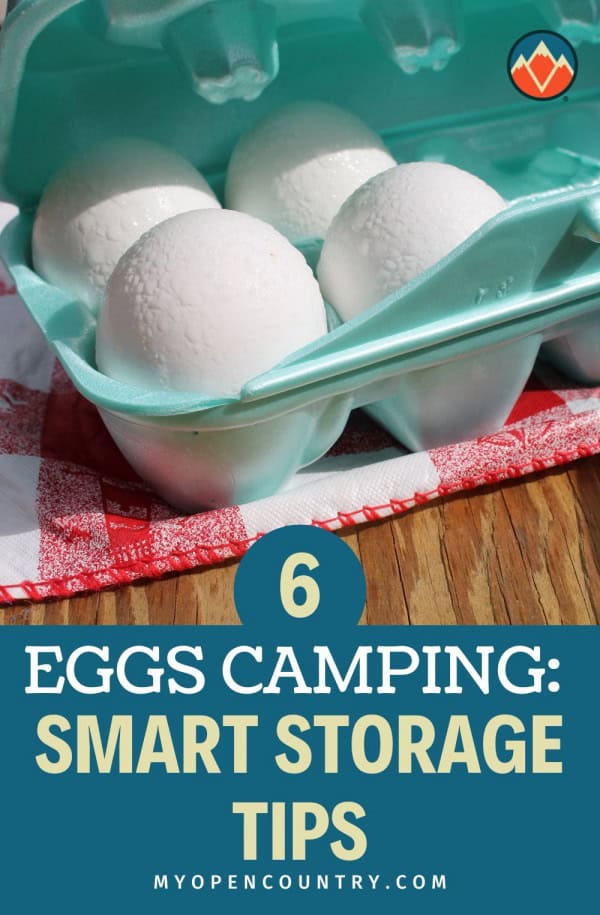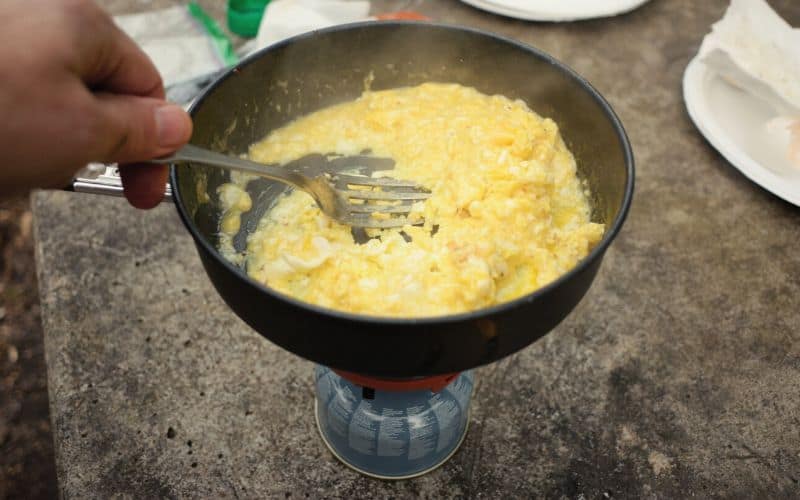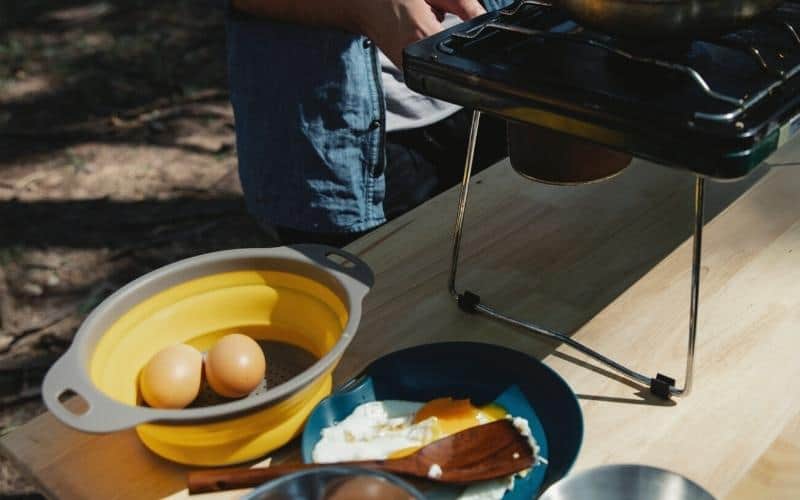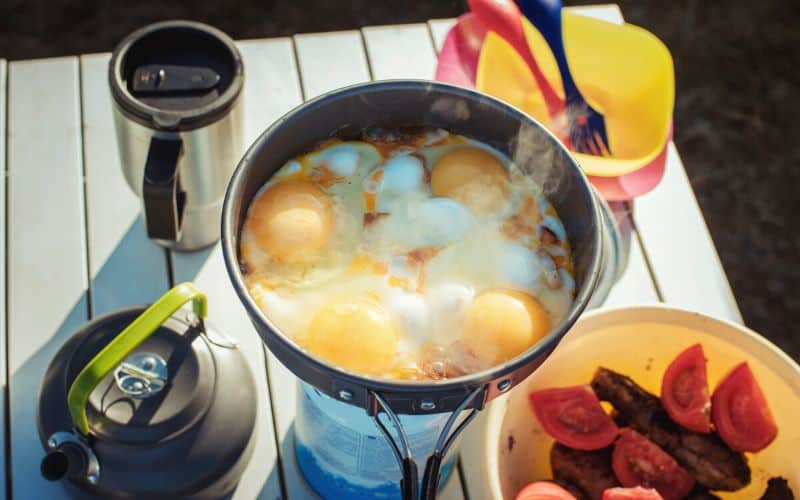When heading on a camping trip, the logistics of getting all your gear to your campsite in one piece can be a bit of a headache. This is never more true than in the case of eggs.
If you’re planning on bringing eggs on your next camping trip, we’re here to help. In this guide, we reveal six easy ways that can minimize the risk of your eggs breaking in transit between home and your campsite
Table of Contents
Save for later!!! ⤵️

1. Boil ‘em!
By far the easiest way to pack eggs is to hard boil them at home before your trip. This method is also the most convenient, allowing you to pack your eggs safely without fear of breaks and spills (we prefer scrambled eggs on our plates, not in our backpacks!).
Grab yourself some farm fresh eggs, stick them in boiling water for 5-10 minutes, leave them to cool for 45 minutes to an hour, then store them in a camping egg holder or egg carton for your trip.

A hard-boiled egg should be stored at 40 degrees Fahrenheit or below. At room temperature, they’ll start to go off after just 8-12 hours, but at 40 degrees they’ll still be safe to eat the next day.
What about boil time? Here’s a rough guide:
- 3 minutes for a soft yolk and set white
- 5 minutes for a firmer yolk and white
- 6 minutes for hard-boiled white and softish yolk
- 8-10 minutes for fully hard-boiled
2. Plump for Powder
The best way to avoid breakage and time-consuming pre-trip prep? Carry powdered eggs!
Powdered eggs (aka ‘dried eggs’) are, as the name suggests, dehydrated eggs in powder form. The benefit of using powdered egg is that they let you forego all the awkward logistics entailed in storing eggs, have an awesome shelf life, and make packing a cinch.
The downsides? Well, you’ll be limited to having scrambled egg or omelet for breakfast.

Pros
- Ideal for long camping trips
- No broken eggs!
- Lightweight and compact (carry your powder inside a plastic bag!)
- No egg shells to dispose of
- Convenient: just mix the powder with cold water and you’ll have a whisked egg ready for cooking
Cons
- Limited to scrambled egg or omelet
3. Pre-Cracked Eggs in a Bottle
One way to avoid an egg breaking and spilling in your backpack is to pre-empt the breakage and pre-crack them at home.
To use this method, grab your store-bought eggs, crack ‘em, then pour them into a standard hiking water bottle/flask, a plastic bottle, or other airtight containers.
As above, your sealed bottle should be stored at or under 40 degrees to ensure the eggs remain fresh.
Pros
- No need to dispose of egg shell at camp
- No risk of breakage and spillage
- Easy to carry raw eggs to camp
- Lets you choose between fried or scrambled egg
Cons
- Extra water bottle(s) needed
4. Use a Plastic Egg Holder
If you’re a stickler for freshness and want to carry whole eggs on your camping trip, there are ways it can be done. The safest is using a plastic carry case like Coghlan’s Egg Holder.
In our experience, egg holders are reasonably secure, but not fully secure because they can still be crushed. And because eggs come in different sizes, they can rattle around inside, which can lead to breakage. To get around this, you’ll need to pack the holder carefully and use a paper towel to plug any gaps.
Worried that your eggs might have gone bad in transit? If so, fill a bowl with water and place them in the bowl. If they sink, they’re fresh and edible. If they float, they’ve gone bad and eating them will pose a risk of food poisoning.
Pros
- Lets you carry whole, fresh eggs to camp
- Lets you prepare boiled, fried, or scrambled egg
Cons
- Holders cost $
- Not entirely safe/secure
5. Store Eggs in a Rice Container
Another way to get whole eggs from home to your campsite is to store them in a rice container. As with any method of storing whole eggs, this method isn’t failsafe, but it’s doable with careful planning and packaging.

Using this method, the rice acts in the same way as all those paper shreds or bubble wrap in fragile packages that arrive in the mail, buffering any external or internal blows that might break your breakfast. Rice works well because, unlike other fillers, it gets into all the small gaps yet is soft enough to absorb shock.
To bring eggs camping using this method, add a half-inch layer of rice to the bottom of a cookie tin, add your egg (keep them a half inch or inch apart), then fill the rest of the tin with rice. To prevent arriving at camp with an eggy-rice mush in your pack, make sure you seal the lid tightly, using scotch if need be.
Pros
- Lets you bring whole eggs to camp
- Lets you prepare boiled, fried, or scrambled egg
Cons
- Bulky
- Heavy
- Not 100% secure
6. Store Fresh Eggs in a Water Bottle
As with the rice method, this method lets you bring whole eggs to camp safely (we hope) by creating a buffer between the eggs and anything that might break them. In this case, however, that buffer takes the form of water.
The water will do two things: help keep your eggs cool and provide the cushioning needed to protect them in transit.

Here’s how it’s done:
Find a wide-mouthed, hard-sided water bottle. Place your eggs in the bottle (carefully!). Fill the bottle with cold water and close the lid. To improve the shelf life of your eggs, insulate the bottle with a sock or plastic bag and refresh the water once you get to camp.
Pros
- Relatively safe and secure
- Water helps to keep eggs fresh
Cons
- Water bottles add bulk and weight
How to Pack Eggs for Camping: 6 Methods
If you’re the kind of camper who loves a little eggy goodness come mealtime, the logistics of getting your breakfast, lunch, or dinner-to-be from home to camp can seem a little daunting. We hope the above list has shown you that this needn’t be the case and you can easily, and safely, get your fill of french toast, omelets, scrambled or fried eggs while out in the wilds!
If you liked this post on how to pack eggs when camping or have any questions, drop us a line in the box below. And if you’d like to share it with your friends, please do!
Save for later!!! ⤵️








